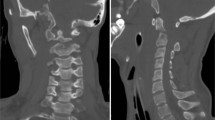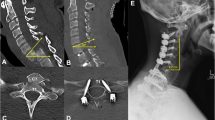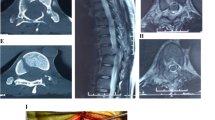Abstract
Introduction
Traumatic injuries of the spine requiring surgery are rare in infancy. Fusion procedures in the very young are not well-described at the atlanto-occipital junction or subaxial spine. Here we describe novel segmental posterior instrumentation in a severe spinal column disruption in an infant.
Case presentation
A 13-month-old male with atlanto-occipital dislocation and severe C6-7 distraction (ASIA impairment scale A) presented after a motor vehicle accident. He underwent instrumented fusion (occiput-C2 and C6-7) and halo placement. Postoperative imaging demonstrated reduction of the C6-7 vertebral bodies. Physical examination showed lower limb paraplegia and preserved upper extremity strength except for mild weakness in hand grip (3/5 on the MRC grading scale). Occiput-C2 instrumentation was performed using occipital keel and C2 pedicle screws with sublaminar C1 polyester tape. C6-7 reduction and fixation was performed with laminar hooks. Arthrodesis was promoted with lineage-committed cellular bone matrix allograft and suboccipital autograft. Anterior column stabilization was deferred secondary to a CSF leak. Intraoperative monitoring was performed throughout the procedure. Within 1 month after surgery the patient was able to manipulate objects against gravity. CT imaging revealed bony fusion and spontaneous reduction of C6-7.
Discussion
Spinal instrumentation is technically challenging in infants, regardless of injury mechanism, particularly in cases with complete spinal column disruption, but an anterior fusion may be avoided in infants and small children with posterior stabilization and halo placement.
This is a preview of subscription content, access via your institution
Access options
Subscribe to this journal
Receive 1 print issues and online access
We are sorry, but there is no personal subscription option available for your country.
Buy this article
- Purchase on Springer Link
- Instant access to full article PDF
Prices may be subject to local taxes which are calculated during checkout



Similar content being viewed by others
Data availability
Data sharing is not applicable to this article as no datasets were generated or analyzed during the current study.
References
Ashafai NS, Visocchi M, Wąsik N. Occipitocervical Fusion: An Updated Review. Acta Neurochir Suppl. 2019;125:247–52.
Haher TR, Yeung AW, Caruso SA, Merola AA, Shin T, Zipnick RI, et al. Occipital screw pullout strength: a biomechanical investigation of occipital morphology. Spine. 1999;24:5–9.
Bauman JA, Hardesty DA, Heuer GG, Storm PB. Use of occipital bone graft in pediatric posterior cervical fusion: an alternative paramedian technique and review of the literature. J Neurosurg Pediatr. 2011;7:475–81.
Hongo M, Ilharreborde B, Gay RE, Zhao C, Zhao KD, Berglund LJ, et al. Biomechanical evaluation of a new fixation device for the thoracic spine. Eur Spine J. 2009;18:1213–9.
Author information
Authors and Affiliations
Contributions
All authors contributed significantly to the preparation of this manuscript. AT and PM wrote the original draft. SL and PS critically revised the content. All authors provided feedback that shaped the final version of the manuscript.
Corresponding author
Ethics declarations
Competing interests
The authors declare no competing interests.
Additional information
Publisher’s note Springer Nature remains neutral with regard to jurisdictional claims in published maps and institutional affiliations.
Rights and permissions
Springer Nature or its licensor (e.g. a society or other partner) holds exclusive rights to this article under a publishing agreement with the author(s) or other rightsholder(s); author self-archiving of the accepted manuscript version of this article is solely governed by the terms of such publishing agreement and applicable law.
About this article
Cite this article
Tucker, A.M., Madsen, P.J., Lang, SS. et al. Technical note: Traumatic atlanto-occipital dislocation and severe subaxial cervical distraction injury in an infant. Spinal Cord Ser Cases 10, 1 (2024). https://doi.org/10.1038/s41394-023-00612-3
Received:
Revised:
Accepted:
Published:
DOI: https://doi.org/10.1038/s41394-023-00612-3



